An economic evaluation incorporates the road’s life cycle costs to help justify the maintenance programme. It will support the financial implications of the what, when, where, why and how type questions. Alternative maintenance scheduling scenarios can be compared to help decide the best use of resources. It is also useful to evaluate road user and authority costs. The evaluation often considers the whole road network, and associated budget constraints and projections.
A key decision that economic evaluation can assist with, is determining how much preventative versus on-demand maintenance is justified. The two diagrams below show the relationship between user costs and the serviceability level for two maintenance strategies. The first shows an on-demand maintenance strategy with major resurfacing required when the serviceability level falls below the terminal level. The second strategy shows preventative maintenance being conducted, effectively increasing the length of time before major reconstruction is required. However, more costs are incurred by the road user as maintenance is more frequent.
The terminal level is set by a mix of legal, regulatory or company thresholds at which the road can no longer meet its intended purpose. One of the following factors will determine that the pavement requires rehabilitation:
- Serviceability falls below the minimum acceptable level
- Structural capacity is inadequate
- Safety is inadequate
- Environmental standards are unacceptable
- High maintenance costs.
All costs associated with the road need to be evaluated to make a valid economic assessment. They need to be assessed over the life of the structure. Discounted cash flow analysis is required so that all expenditure and income occurring over the road’s lifetime, or analysis period, is adjusted to a common base time or value.
The formulae associated with economic analysis will not be covered in this Manual. There are numerous specialist books on the subject. Refer to Chapter 1, which further covers the factors to consider in an economic analysis.
Rehabilitation of a pavement usually means construction work is needed to stabilise, reshape and rejuvenate the pavement to increase user safety, and decrease user and maintenance costs. This is usually taken as the end of a pavement’s useful life, and a new economic analysis is completed for the next design period.
The relationship between costs and serviceability